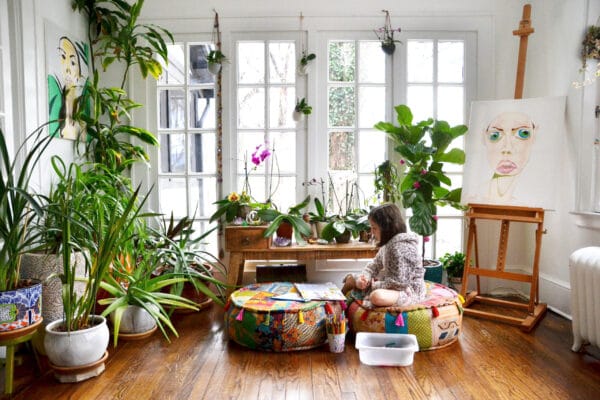Houseplants are great additions to any home. Beyond their beautifying nature, they are perfectly natural air purifiers as they boost oxygen levels and reduce carbon dioxide levels in a house. Psychiatrists also argue that caring for houseplants could be therapeutic because the activity has proven abilities to keep stress levels in check. But as therapeutic as it could be, taking care of houseplants can be hectic to many people; it doesn’t leave any room for trial and error or guesswork.
Here are 5 tips to help your houseplants survive indoors
1. Provide the right amount of light
How much light is enough for your plants? Well, plants’ lighting needs vary from plant to plant.
There are some houseplants that require very minimal natural light to survive. They include the Dracaena plant, Philodendron, and snake plant among others. You only need to place them close to a window that allows in minimal rays of natural light from the outside. You can also use mirrors to reflect light to plants placed in the dark corners of your house, and they will be just fine.
However, some plants such as polka-dot plants and Aloe Vera require at least 6 hours a day indirect light. The good thing is that you can imitate the sun indoors by installing T5 grow light bulbs. These bulbs are energy efficient, easy to set up and maintain, and are cheap in the long run.
Bonus tip: Consider hanging plants if you don’t have enough lighting as most of them survive best under very low light. These plants include the ZZ plant, Pothos plant, and the Chinese evergreen plant.

2. Watering correctly
Watering depends on individual plants- their specific nature and growth patterns. Some house plants such as Orchids, Sago Palm, and the Red Aglaonema, for example, can survive for long without water. They are ideal for homeowners who travel a lot and those who can’t keep up with a regular watering schedule. Also perfect for regions whose temperatures are warm all year around. For others like the Begonias, frequent watering is necessary to avoid wilted leaves and drying up.
Is tap water good for houseplants? Yes. Tap water is perfectly okay. However, for some acid-loving houseplants like the Azaleas, Blueberry plants, and gardenia, you can use wet tea leaves as a substitute for watering to keep them looking more luxurious and lively.
3. Maintain the necessary humidity for your houseplants
On average, plants need humidity of between 40%-60%. Maintaining humidity in your home at such high levels is a challenge especially during winter when the air is relatively dry. That is why many houseplants’ leaves turn yellow and develop brown edges in winter. The easiest ways of increasing humidity for your indoor plants include:
Pebble Trays: This involves putting pebbles on a tray and almost fully covering them with water. By so doing, the pebbles are able to hold the plant above the water and shield the roots from becoming too wet. The moisture around the plant increases as the water in the tray evaporates.
Misting: Misting is best applicable to plants such as majesty palm and Fern. However, this method is not applicable to drought-resistant plants such as succulents.
Humidifier: When the air is too dry, you can consider turning on a humidifier for a few hours, most preferably in the morning hours.
Pro tip: If you live in a notoriously low-humidity environment, it is best that you bring in plants that thrive in low humidity, e.g. cacti.
4. Growing medium
Which growing medium is best for your plants? Again, this depends on the nutrient requirement of individual houseplants. Tillandsias and Orchids, for example, can survive with only water and air- no soil needed. Containerized house plants, on the other hand, require potting soil mix which is different from the soil in your backyard.
You can DIY different potting soils using manure, topsoil, recycled home waste, gravel, and sand among other components. Be sure to check the nutrients needs of your plants before preparing your potting soil mix. While at it, ensure that you use the right pot size for each of your plants. The pots should be spacious enough to allow for the roots to spread as they should and for sufficient air circulation. They should also have adequate drainage because excess, stagnant water is one of the leading causes of root rot.
5. Check for diseases and pests
You need to inspect your plants regularly for bugs, red spider mites, and Aphids, among other pests that attack plant leaves and stem. Clean them regularly with water and soap. Also, ensure that any plants coming from the outside are clean and free from any pests.
Houseplants also suffer from incurable diseases. These include stem or root rot, bacterial leaf spots, fungal leaf spots, Powdery mildew, and gray mold, among others. It is highly important to prevent them before they attack by meeting the lighting, humidity, and watering needs of each plant. You also need to consult local gardeners on the best bug spray to use for each of your plants’ types. Lastly, withdraw any affected plants before they infect the others.
Final word
It is important to do thorough research before bringing in house plants. Some plants will just not survive in your area/home no matter the care you provide them. Make a habit of checking for abnormalities and seeking expert advice before any irreversible damage is done to your plants.
Watch this space for updates in the Hacks category on Running Wolf’s Rant.
Like what you just read? Subscribe To Our Newsletter to stay in the loop.
Feel free to explore our website or check out our Featured Articles.
Looking for a gift for that special person in your life? Check out Netflorist.co.za, South Africa's top online florist and gift service. They offer flowers, gifts, and hampers for all occasions AND reliable nationwide delivery.


